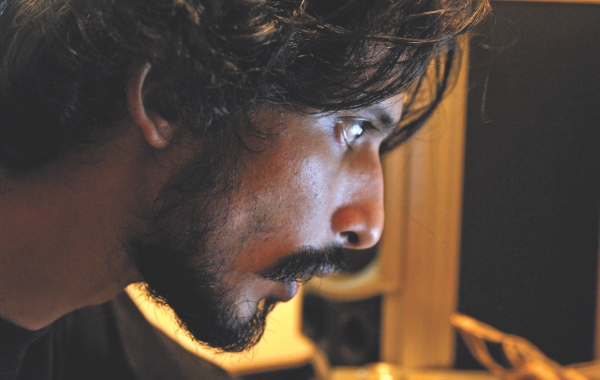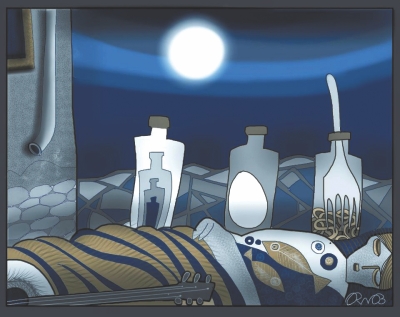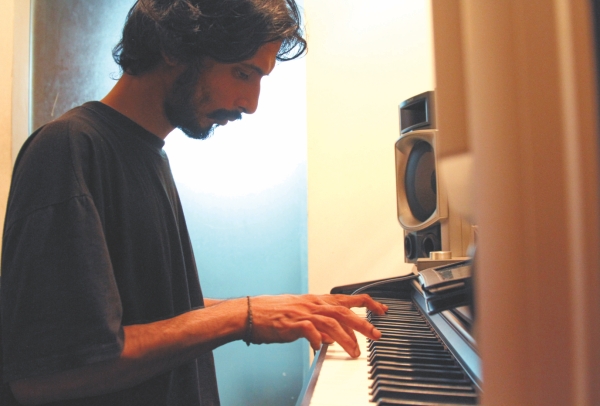| Home - Back Issues - The Team - Contact Us |
 |
| Volume 11 |Issue 29| July 20, 2012 | |
|
|
Profile The Artiste Sushmita S Preetha and Amirul Rajiv
Being famous is never easy, especially for someone who has never consciously sought it. It entails relinquishing control over a part of one's life – the loss of anonymity, the loss of privacy and peace of mind. But it is harder still to give it all up, when one is at the peak of one's popularity. Unlike those celebrities who find it difficult to resist or escape the seductive charms of fame, Shayan Chowdhury Arnob, the talented artist who single-handedly changed the music scene in Bangladesh with his unique and versatile music style, feels that it's now time to go. “It's a drag for me, being Arnob, this musician Arnob. No matter how hard I try, I can't seem to get rid of this character,” says Arnob, woefully, as he carelessly plays with the strings of his guitar. “I think I am going to completely cut it out of my life. If I do music, it will be only for myself.” It's a surprising revelation from the musician who has recently released his fifth album, Adhek Ghume, his ode to his biggest inspiration, Tagore. Arnob began his musical journey as the founder-member of the fusion folk band, Bangla, formed back in Shantiniketon while he was still a student. Bangla gained immense popularity with its debut album, Kingkortobbobimuro, but it was really his single, Shey je boshe ache eka eka, and subsequent solo albums that established Arnob as a pioneering voice in Bangladeshi music. “The beginning was good,” recalls Arnob. “Initially I thought it was a short-cut to establish myself musically and to get through, which happened. But after a while, when you've worked with a lot of people and produced a few albums, music becomes like computer typing – an isolation happens.”
It's this overwhelming feeling of isolation both in his work and personal life that troubles Arnob and leads him to question the purpose of his life. “I can't see myself alone in this house for the rest of my life, where there is no light or human interaction, making music in a mechanised manner. I don't see myself jumping around on stage, interacting with random people, when I am really tired, and singing songs I don't want to sing,” says Arnob. And despite the constant attention he receives no matter where he goes, he feels overpoweringly alone, for very few people can look beyond his rockstar image and relate to him as a normal person. “When I was in Shantiniketon, I was with a lot of people, then in relationships, but I've always thought that, no matter how many people there are around me, I am a loner. But when it actually happens, the isolation, the loneliness, it is sometimes unbearable,” he explains. Arnob feels that it is time to explore a different path – a career as a visual arts artist and an academic. It was, after all, fine arts that he had studied in Shantiniketon, not music, and he envisions himself using art in a novel and creative way to engage the younger generations. As he says, “If I have something to give musically, I still will, but if I want to make a meaningful impact, I want to do so by teaching, by sharing the sort of education I received (in Shantiniketon) and which perhaps we will see in this country someday.” Arnob believes that the education system will change radically over the next few years, and teachers will have to find nuanced methods to involve the new tech-savvy generation in the learning process. “We can use art and technology to make them think critically; instead of telling them what to do, we need to ask them to find the solution themselves. Technology has made information very accessible and interactive, and we need to know how to make the most use of it,” he states. For instance, Arnob wishes to use digital media to narrate stories for the future generation. “If I want to explain the humour of Shukumar Roy, it'll be difficult for me to do so with a book, but if I can make it a little more interactive, it'll work. Apps these days narrate a story so beautifully; they make the audience a part of the story. Imagine the range of creative things you can do with Hojoborolo using digital art and animation. It might be the only way we can ensure that our stories are passed on,” says Arnob, as he fiddles with his iPad, showing us different apps that allow him to create artwork. “Isn't it amazing?” he gushes, as he transforms an image with a few clicks and swishes of his finger. Arnob's painting and prints – which he hasn't as yet exhibited in public – are as interesting and brilliant as his music. But his two loves complement, rather than contradict, each other. As Arnob says, “When I am tired of my music, I look to my art, which is what I am doing now; and when I was involved in my arts, I enjoyed making music because there was no pressure to produce good music.” One hopes, then, that his intention to venture into 3D animation and visual arts does not signify an end to his music career, but rather adds another dimension to his creativity. Adhek Ghume might well be the last album for a long time to come, even though Arnob assures us that he will still be involved with music if he comes across good opportunities. The album features Arnob's unique interpretations of 12 Tagore songs. In it, Arnob has tried to explore the connection between Tagore and piano structures and patterns. In many ways, it's an experiment, a part of an ongoing research. He explains his vision for the album: “Jyotindranath, Rabindranath's elder brother, who was a very dynamic person, used to play the piano. He used to compose different patterns based on a fusion of Indian and Western scales and ask Rabindranath to put words to them and sing. So that had a strong influence on him, at least on a subconscious level. He had a schooling of laying his words on top of some foundation/composition, which was probably Jyoti's piano notes.”
Arnob says that the realisation had struck him recently, that it didn't come to him even when he was in Shantiniketon, playing the same piano Tagore used to play. “Just as I was feeling drained doing the same thing again and again, it suddenly occurred to me two years ago – where does the typical sound of a Tagore song come from, apart from the ones he borrowed from other places or people? If you play a few very simple chords, and keep on repeating them, everything falls into place perfectly; then even if you omit the piano part, it doesn't matter because the remaining structure itself is so strong that it falls into place automatically. What I wanted to do was to go back and trace those reference points – what they are and what they could be.” Many traditional Tagore enthusiasts have criticised Arnob for “tampering” with Tagore's songs and making changes to what they consider “sacred texts”. Arnob, however, feels that he has remained true to Tagore. “I haven't broken the structure or the tunes of the songs. See, for me, it's not only about establishing a connection, but about me taking refuge – going back to the roots,” he says. “I am not trying to establish myself as a Tagore singer and I am not trying to establish that Tagore definitely had this vision.” Arnob says he learnt the songs in his childhood in a particular way, without fully understanding their significance, but now when he sings them, he finds new meanings, new symbols and images. “That's why sometimes I didn't sing the whole song; I sang it the way it resonated with me.” Interestingly, the last song of his album is a theme song of Robi Axiata Ltd – the mobile phone company, not the kobi-guru. Arnob is no sell-out; in fact, he produced his first album by himself, burning the CDs and printing the album covers and selling them by hand. His decision to collaborate with a mobile operator is an attempt to make sure that he gets the copyright to his songs, as well as get a fixed amount every time someone downloads one of his songs. “The shopkeepers buy the CD for Tk 30 and sell it for Tk, 80. Meanwhile, of the 30, Tk 21 goes for packing etc. and the rest of it has to be divided between the company and the artiste. I think it's very unfair,” he asserts. In Bangladesh, artistes don't usually have copyrights of their music, which can hence be reproduced without the permission of the artist. “I am very serious about giving artists their rights, respecting the content and helping the musicians – which is what I've tried to do with ABC radio. A certain phone company has used my songs over the years as welcome tunes but have given me no money for it. They milked and exploited me,” complains a frustrated Arnob. Arnob hopes that soon we can digitalise the music industry, which can help ensure the survival of local artists. “People still don't use ATM cards to buy local products, we don't have the infrastructure. But if Digital Bangladesh finally comes, we can upload the songs in a better format, and then people wouldn't mind buying a song for Tk 10 or an album for Tk 50, and then we will cut the middleman altogether,” he says. “Making music in this country is not sustainable. Back in the days, the emperor would say, I will look after you, you just create art. And that's when classical music flourished. The state is least bothered about promoting musicians, and I don't see how I can sustain myself like this. Doing music is becoming a stress, a problem.” It is obvious that the multi-talented artist feels alienated from his work for a variety of reasons. It is equally apparent, however, that he is much too talented and much too passionate about his work to leave the Bangladesh art scene altogether. Only time will tell if Bangladesh will lose one of its most beloved artists, or gain one, albeit in a new form.
|
||||
Copyright
(R) thedailystar.net 2012 |


